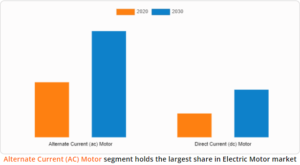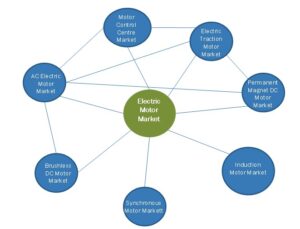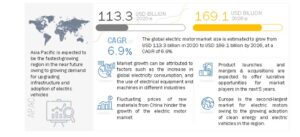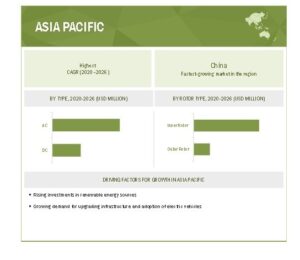Electric Motor Industry Trends
Electric motors are electromechanical devices that operate on the electromagnetic induction principle. They are long-lasting and efficient, require little maintenance, use less energy, and can withstand voltage fluctuations. Furthermore, electric motors are far less expensive than fossil-fuel engines. Electric motors are used in a wide range of industries, from vehicles to oil and gas, where they are found in industrial fans, industrial machinery, compressors, electric cars, residential appliances, hard disc drives, and other applications.

Fig: 1 Electric motor market by motor type
The market for electric motors is divided into four categories: motor type, output power, application, and country. The market is segmented into two types of motors: alternative current (AC) motors and direct current (DC) motors. The market is segmented into integral horsepower (IHP) and fractional horsepower (FHP) outputs based on output power. The market is divided into automotive, HVAC, medical equipment, industrial machinery, home appliances, and others based on application.

Fig: 2 Market Interconnection
North America, Europe, Asia-Pacific, and LAMEA are all included in the worldwide electric horsepower motor market analysis. Asia-Pacific was the largest contributor to global electric motor market share in 2020, and it is expected to maintain that position throughout the forecast period.
Energy-efficient electric motor
End-user sectors like electricity and energy, automobiles, and others have had a significant demand for energy-efficient motors. They do, however, need energy-efficient electric motors to cut their energy expenses. Furthermore, such engines cut carbon emissions, assisting businesses in meeting their environmental goals. Furthermore, several governments have enacted tough rules that will enhance future demand for energy-efficient electric motors.
Rise in prices
By 2022, an increase in global steel prices is predicted to raise the price of electric motors by 15% to 20%. Such modifications will have an impact on the pricing of motors that meet IE2 and IE3 efficiency criteria. Even though the cost of energy-efficient electric motors may rise, purchasers can save money on their energy bills.

Fig: 3 Global forecast
Market Overview
During the projected period of 2020–2025, the electric motor market is likely to develop at a CAGR of over 7%. The market is likely to be driven by factors such as increased environmental concerns and expanding demand for electrical energy. The electric motor industry is predicted to develop as the need for energy usage grows in response to concerns about the environmental impact of energy production from traditional energy such as coal and natural gas. However, the market’s growth has been hampered by a general lack of awareness among small and medium businesses about the benefits of smart motors.
The automotive sector is expected to grow significantly over the forecast period, owing to several factors including an increase in electric vehicle sales as a result of rising concerns about greenhouse gas emissions, as well as favorable government policies in countries such as Norway and China.
To meet the growing demand for electrical energy, large expenditures in power generation must be made constantly. This has aided the market for electric motors in recent years, and it is projected to continue to do so in the forecast term. Electric motor applications account for over 40% of worldwide energy demand.

Fig: 4 World’s largest contributor
Due to reasons such as economic growth in emerging nations, growing adoption of electric vehicles, and increased industrial activities, Asia Pacific is predicted to dominate market growth, with the majority of demand coming from countries such as China and India.
Key Market Trends
- Due to rising customer demand for greener automobiles and favorable government policies, the market for electric vehicles is likely to rise substantially in the forecast period.
- Reduced taxes and large subsidies on electric vehicles in countries like China and Norway have resulted in a quick growth in sales and cleared the way for electric motors to become more prevalent in the automotive industry.
- In 2018, a total fleet of 5.1 million electric vehicles avoided almost 36 Mt of CO2-eq when compared to a fleet of the same number of internal combustion engines.
- The connection between the two appears even more relevant now that electric motor production costs have dropped dramatically in recent years, efficiency has increased, and adoption has reached an all-time high.
- As a result, the mentioned factors are projected to aid market growth over the forecast period.
ElectricmotorshopJobs.com keywords: electric motor market trends, electric motor jobs, electric motor industry trends, electric motor trends


